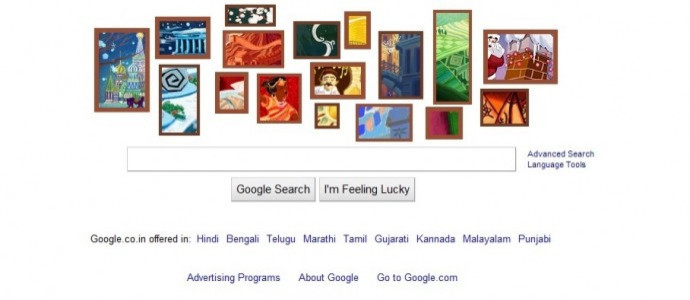Google Logo Doodle Is Live With Christmas Spirit

Google Inc. has started its 2010 Christmas with new holiday doodle, which has 17 interactive images of holiday destinations and cuisines from around the world. The new holiday doodle was launched at 9 a.m. ET on Thursday and will stay up on the home page until Christmas is over.
Google dedicated the festive season to some delicious cuisines and some holiday destinations where people would love to roam and would enjoy a break from hectic lives.
A doodle is a sketch, an unfocused drawing made while a person's attention is otherwise occupied. The word doodle first appeared in the early 17th century to mean a fool or simpleton. The meaning fool, simpleton is intended in the song title Yankee Doodle, originally sung by British colonial troops prior to the American Revolutionary War.
This is also the origin of the early eighteenth century verb to doodle, meaning 'to swindle or to make a fool of'. The modern meaning emerged in the 1930s either from this meaning or from the verb 'to dawdle', which since the seventeenth century has had the meaning of wasting time or being lazy.
Micheal Lopez is responsible for Google's Doodles, those delightful illustrations that crop up over the course of the year to celebrate holidays, pop-cultural moments, civic landmarks and scientific achievements, according to the Wall Street Journal.
Doodles appear throughout the year to commemorate holidays, pop-culture touchstones, civic milestones and scientific achievements. Micheal Lopez's concept took 5 artists about 250 hours to complete.
For Google, the goal is to burnish its brand image and engage the legions of people who conduct more than a billion searches a day, without offending any of them. Google estimates it has created more than 900 doodles since 1998, with 270 of them running in 2010. Some appear globally, and others are tailored for local markets outside the U.S., such as Kenya Independence Day, according to the Journal.
17 Interactive Images
St. Basil's Cathedral -- a Russian Orthodox cathedral erected on the Red Square in Moscow in 1555–1561.
The Acropolis of Athens or Citadel of Athens -- the best known acropolis in the world. The Acropolis of Athens is a flat-topped rock that rises 150 meters (490 feet) above sea level, with a surface area of about 3 hectares.
Bûche de Noël -- a traditional dessert served during the Christmas holidays in France, Belgium, Quebec, Lebanon, Vietnam, and several other Christian-populated francophone countries and in the UK.
Mount Fuji -- the highest mountain in Japan at 3,776.24 meters (12,389 feet).
The Great Wall of China -- a series of stone and earthen fortifications in northern China. The Great Wall stretches from Shanhaiguan in the east, to Lop Nur in the west, along an arc that roughly delineates the southern edge of Inner Mongolia.
Pierogi -- a boiled, baked or fried dumplings of unleavened dough stuffed with varying ingredients. They are a part of traditional Ukrainian, Polish, and Russian cuisine.
Indian classical dance or Indian dance styles -- Dance in India covers a wide range of dance and dance theatre forms, from the ancient classical or temple dance to folk and modern styles. India offers a number of classical Indian dance forms, each of which can be traced to different parts of the country.
Sahara desert -- the world's largest hot desert. At over 9.4 million square kilometres (3.63 million square miles), it covers most of Northern Africa, making it almost as large as Europe or the United States. The Sahara stretches from the Red Sea, including parts of the Mediterranean coasts, to the outskirts of the Atlantic Ocean.
Oud -- pear-shaped stringed instrument commonly used in North Africa and Middle Eastern music.
Chili pepper -- the fruit of plants from the genus Capsicum, members of the nightshade family, Solanaceae. Chili peppers originated in the Americas. After the Columbian Exchange, many cultivars of chili pepper spread across the world, used in both food and medicine.
Sydney Harbour Bridge -- a steel through arch bridge across Sydney Harbour in Australia that carries rail, vehicular, bicycle and pedestrian traffic between the Sydney central business district and the North Shore. he bridge is locally nicknamed The Coat Hanger because of its arch-based design.
Venice gondolas -- a traditional, flat-bottomed Venetian rowing boat, well suited to the conditions of the Venetian Lagoon. For centuries gondolas were once the chief means of transportation and most common watercraft within Venice.
Nepal -- officially the Federal Democratic Republic of Nepal, is a landlocked country in South Asia. It is located in the Himalayas and bordered to the north by the People's Republic of China, and to the south, east, and west by the Republic of India. The rich cultural heritage of Nepal has evolved over centuries.
Chilean vineyards -- Chile produces some of the best wines in the world so you cannot leave the country without having visited one of the vineyards first. Chilean wine is wine made in the South American country of Chile. Chile is the fifth largest exporter of wines in the world, and the ninth largest producer, according to census taken in 2005.
African kanga -- a colourful garment similar to kitenge, worn by women and occasionally by men throughout Eastern Africa. It is a piece of printed cotton fabric, about 1.5m by 1m, often with a border along all four sides (called pindo in Swahili), and a central part (mji) which differs in design from the borders.
Up on the House Top -- a Christmas song written by Benjamin Hanby in 1864 in the town of New Paris, Ohio. According to William Studwell in The Christmas Carol Reader, Up on the House Top was the second-oldest Christmas song of a secular nature, outdone only by Jingle Bells, which was written in 1857.
Henna lamp -- a decorated lamp made by hand with a hand-painted geometric design.
© Copyright IBTimes 2024. All rights reserved.





















